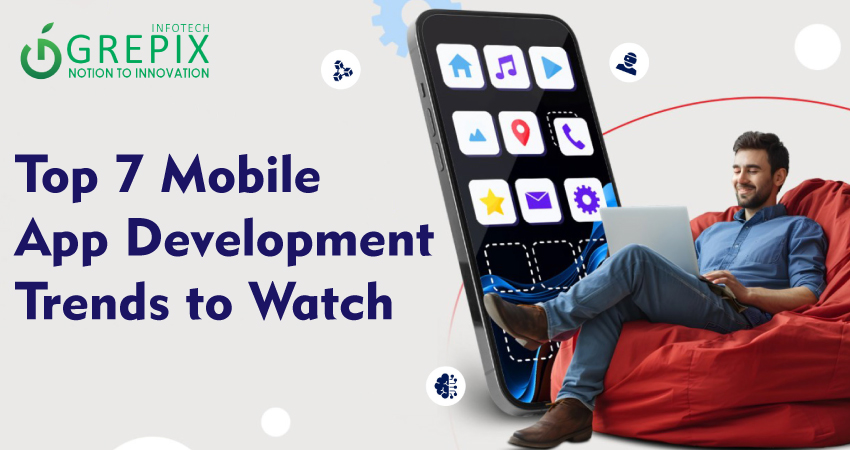Top 7 Mobile App Development Trends to Watch
In the fast-paced world of mobile technology, 2025 is proving to be a transformative year for app development. Innovations like artificial intelligence, 5G networks, and the Internet of Things are reshaping how we interact with our devices, offering unprecedented opportunities for developers and businesses alike. Our guide, "Top 7 Mobile App Development Trends to Watch", dives into the most impactful trends driving the industry forward this year. From AI-powered personalization that tailors user experiences to 5G's lightning-fast connectivity enabling seamless interactions, these trends are not just about keeping up they're about leading the way. Whether you're a developer pushing the boundaries of innovation or a business aiming to captivate your audience, understanding these trends is key to staying competitive.
Join us as we explore the technologies and strategies set to define mobile app development in 2025.
Let’s face it our phones are practically part of our bodies now. They’ve come a long way from just being a tool for calling or texting. These days, they're our cameras, wallets, personal assistants, entertainment hubs, and so much more. Thanks to cutting-edge innovations like 5G networks, foldable smartphones, and AI integrations, mobile technology has reached a whole new level.
So what does this mean for the future of mobile apps?
Mobile App Development is evolving rapidly. From cross-platform solutions to apps that don’t even need to be downloaded, 2025 is shaping up to be a game changer.
Discover how to leverage these advancements to create apps that are smarter, faster, and more engaging than ever before. In this blog, we’ll dive deep into the top mobile app trends you absolutely need to keep your eye on this year.
This blog explored the Top 7 Mobile App Development Trends to Watch in 2025. These include cross-platform evolution, PWAs, instant apps, on-device AI, 5G technology, foldable device adaptations, and AI-driven personalization. Each trend plays a key role in enhancing user experiences and shaping the future of mobile technology. Businesses and developers alike should stay ahead by adopting these game-changing strategies.
1 Cross-Platform Evolution: One Codebase, All Platforms
Back in the day, if you wanted your app on both iOS and Android, you had to build two separate versions. That meant double the effort, double the cost, and double the headaches. Fast forward to today, and we’re seeing a massive shift towards cross-platform development.
Why It’s a Game-Changer
Cross-platform frameworks allow developers to write code once and run it across multiple platforms. This is not only cost-effective but also helps businesses maintain a consistent user experience.
Top Tools in the Game
- Flutter by Google: Known for its rich UI and native performance.
- React Native by Meta: A solid choice for scalable apps.
- Xamarin by Microsoft: Good for integrating with the .NET ecosystem.
- Kotlin Multiplatform: A newer player that’s gaining traction fast.
Real-World Example
The BMW Group used Flutter to build its My BMW app for both Android and iOS platforms. It helped them cut development time significantly while delivering a polished user experience.
Bottom Line
With the rise of cross-platform tools, expect more developers to hop on this train. After all, best app technology is all about doing more with less.
2 Progressive Web Apps (PWAs): A Hybrid Experience
Ever used an app without actually installing it? That’s a Progressive Web App (PWA) in action. These are essentially web applications that act like native apps.
Why They’re a Big Deal
- No Installation Needed: Just visit a link, and you’re good to go.
- Offline Functionality: PWAs can work even when you’re not connected.
- Smaller Storage Footprint: Great for users with limited device storage.
Global Examples
- Twitter Lite: Offers a full Twitter experience with less data usage.
- Starbucks PWA: Increased their daily active users significantly.
- Forbes PWA: Loads in less than 3 seconds, even on flaky networks.
Developer Perks
- Less dependency on app stores.
- Easier updates and rollbacks.
- A single codebase for all browsers and platforms.
Why It’s Trending
PWAs offer the best of both worlds the reach of the web and the performance of native apps. No wonder they’re among the top mobile app trends today.
3 Instant Apps: Try Before You Buy
Let’s be real no one likes downloading an app just to try it out for a minute and then delete it. That’s where Instant Apps come in.
What Are Instant Apps?
They’re lightweight versions of apps that run without needing to be installed. Android has been a frontrunner in this space with Google Play Instant.
Why Users Love Them
- Zero Wait Time: Use the app immediately.
- Saves Storage: No bulky files clogging your phone.
- No Commitment: Try it before you commit to downloading.
Use Cases
- Gaming: Try a demo level before installing the full game.
- E-commerce: Preview shopping features or browse products instantly.
- Service-Based Apps: Book a cab or reserve a table without downloading.
Business Benefits
- Higher user acquisition.
- Better engagement rates.
- Improved conversion funnels.
Example
NYTimes Crossword offers an Instant App experience that lets users play a sample puzzle right from the Play Store—no download needed.
4 On-Device AI: Smarter Apps Without the Cloud
AI used to mean sending data to the cloud and waiting for results. Not anymore. On-device AI is making apps smarter and faster, without compromising user privacy.
Why It Matters
- Real-Time Processing: Get results immediately.
- Better Privacy: Your data stays on your device.
- Offline Functionality: Works even when you’re not online.
Popular Applications
- Photo Editing Apps: Real-time filters and object recognition.
- Language Translators: Translate on the fly without an internet connection.
- Voice Assistants: Siri and Google Assistant now do a lot more locally.
Developer Tools
- Core ML (Apple)
- ML Kit (Google)
- TensorFlow Lite (cross-platform)
Why It’s a Trend to Watch
Users demand fast, private, and intelligent apps. On-device AI delivers exactly that, making it a cornerstone in modern Mobile App Development.
5 5G Technology: Powering the Future
You’ve probably heard all the hype around 5G and it’s justified. With speeds up to 100x faster than 4G, it’s not just about quicker downloads. It’s about unlocking a new generation of mobile experiences.
What 5G Enables
- Real-Time AR/VR: Smooth, immersive experiences.
- High-Quality Streaming: Buffering is a thing of the past.
- Faster App Load Times: Say goodbye to lag.
- IoT Integration: More devices, better connectivity.
Global Use Cases
- Telemedicine Apps: Real-time consultations without video lag.
- Smart Cities: Apps managing traffic flow and public safety.
- Cloud Gaming: Platforms like Stadia and Xbox Cloud Gaming run better on 5G.
Why Developers Should Care
Faster speeds mean richer app features. You can build things that simply weren’t possible before making your app stand out from the crowd.
6 Foldable Phones: Design for Dual Screens
Foldable phones are no longer futuristic concepts. They’re here, and they’re selling like hotcakes. But they require a different approach when it comes to app design.
Unique Challenges
- Dynamic Layouts: Apps must adapt to folded and unfolded modes.
- Multi-Window Support: Users may run multiple apps side by side.
- Continuity: Seamless transitions between screen states.
Opportunities
- Gaming: Use the second screen as a controller or map.
- Streaming: Watch videos on one half, chat on the other.
- Productivity: View a spreadsheet and edit a document simultaneously.
Developer Best Practices
- Use responsive design.
- Test on multiple screen configurations.
- Leverage Android’s and Samsung’s foldable device APIs.
Global Trend
Samsung Galaxy Fold, Huawei Mate X, and others are making foldables mainstream. Designing apps with them in mind is no longer optional—it’s the future.
7 AI Integrations: Personalize Everything
Let’s be honest people love apps that “just get them.” That’s the magic of AI. It allows apps to learn from user behavior and personalize the experience.
Examples of AI in Action
- Spotify: Recommends music based on your tastes.
- Netflix: Curates shows just for you.
- Amazon: Knows what you’ll want to buy before you do.
How It Enhances User Experience
- Predictive Search: Find what you’re looking for faster.
- Smart Notifications: Alerts based on your habits.
- Chatbots: Handle queries instantly, 24/7.
Why Businesses Love It
- Increased Retention: Users stick around for personalized experiences.
- Boosted Engagement: Tailored content means more interaction.
- Better ROI: Smart apps drive smarter decisions.
Future Potential
As AI gets more advanced, we’ll see apps becoming not just tools, but companions that adapt and evolve with the user.
Conclusion
The mobile app space is evolving fast and only those who stay ahead of the curve will thrive. Whether it’s building for foldables, integrating AI, or leveraging the speed of 5G, there’s no shortage of opportunities. By embracing these mobile app trends, developers and businesses can not only meet user expectations but also redefine them.
In today’s ever-evolving digital world, staying ahead in mobile app development isn’t just an option it’s a necessity. From cross-platform frameworks and AI integrations to blazing-fast 5G and innovative foldable devices, the trends shaping 2025 are both exciting and full of potential. Whether you're a startup looking to make a mark or a large enterprise aiming to expand your digital footprint, embracing these innovations can redefine user engagement and drive sustainable growth.
That’s where Grepix Infotech comes in. As a leading mobile app development company, Grepix has consistently delivered cutting-edge, scalable, and user-friendly mobile solutions for clients across the globe. With a strong focus on emerging technologies and user-centric design, Grepix ensures your app isn’t just functional it’s future-ready. Their team of expert developers and designers leverages the best app technology to bring your vision to life, whether it's iOS, Android, cross-platform, or custom enterprise solutions.
With Grepix Infotech by your side, you’re not just keeping up with mobile app trends you’re setting them. Partner with Grepix to build powerful, intuitive apps that resonate with users and drive real business results.
Innovate smart. Develop with Grepix. Your app's future starts here.
FAQs
1. What are the benefits of cross-platform app development?
It reduces development time and cost while ensuring a consistent user experience across platforms like iOS and Android.
2. How do PWAs differ from native apps?
PWAs are web-based apps that work like native apps but don’t require installation and offer offline capabilities.
3. Are Instant Apps only available on Android?
As of now, Google Play Instant is Android-exclusive, but similar concepts may emerge for other platforms.
4. Why is on-device AI better than cloud-based AI?
It offers faster processing, enhanced privacy, and works offline perfect for real-time and sensitive applications.
5. Do all apps need to support foldable phones?
Not yet, but with the rise of foldables, it’s wise to future-proof your apps for these devices.
Looking to build your own mobile app? Try out Grepix Infotech – your one-stop destination for custom mobile app development. Visit us today to get started!"







